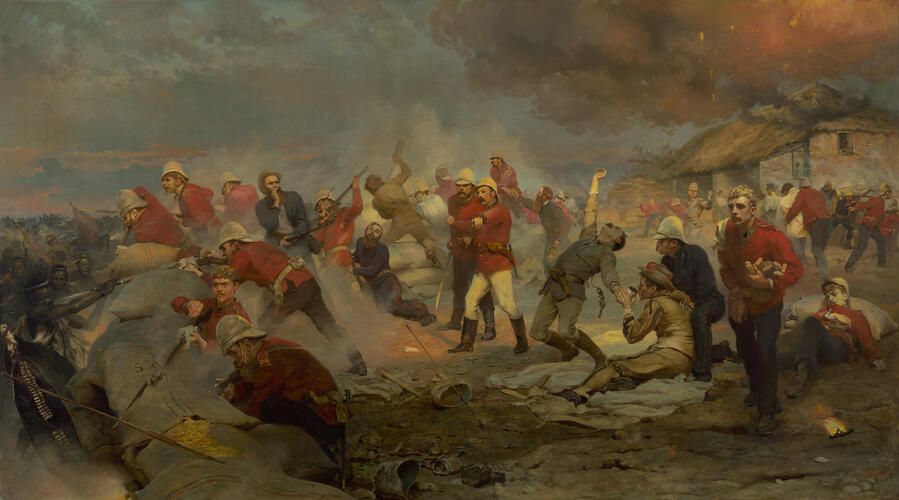-
1 of 253523 objects
The Defence of Rorke's Drift Signed and dated 1880
Oil on canvas | 120.2 x 214.0 cm (support, canvas/panel/stretcher external) | RCIN 405897
-
The battle of Rorke's Drift was fought in the Anglo-Zulu war in South Africa in 1879. Rorke's Drift was a mission station, originally a farm owned by James Rorke, an Irish trader. The station, part of which had been turned into a small field hospital, was defended by 141 British soldiers against an attack from about 4,000 Zulu warriors under the command of Prince Dabulamanzi, half-brother of Prince Cetshwayo. The defence of the station was commanded by Lieutenant John Chard of the Royal Engineers. In recognition of the heroism displayed by the defenders 11 Victoria Crosses were awarded.
Elizabeth Thompson, Lady Butler was a specialist in military subjects, influenced by French military painters, particuarly Detaille. Her 1874 painting The Roll Call, RCIN 405915, which depicted a battalion of wounded and exhausted Grenadier Guards lined up for a roll call following an engagement during the Crimean War, enjoyed phenomenal success when it was exhibited at the Royal Academy, turning its painter into a national celebrity. The painting was subsequently acquired by Queen Victoria, who went on to commission this painting from the artist.
The defence of Rorke's Drift captured the public imagination and when the soldiers returned to England they first visited Windsor, before being sent to Lady Butler. She went to Portsmouth, where the regiment was quartered, and they put on a representation of the battle for her 'dressed in the uniforms they wore on that dreadful night …the result was that I reproduced the event as nearly to the life as possible'. The artist stated that she had 'managed to show, in that scuffle, all the V.C.'s and other conspicuous actors in the drama'. In the painting the Zulu soldiers are attacking the north-west corner of the station. In the background the roof of the hospital is on fire.
Lieutenant Chard is in the centre, pointing with his left arm, next to Lieutenant Bromhead who is holding his sword. When Queen Victoria saw the painting she noted: 'All, officers & men, are portraits, & everything is painted from descriptions, & just as it was, down to the very smallest detail'. The painting was exhibited at the Royal Academy in 1881.
This work is connected to colonialism and imperialism. Like all Royal Collection records, this work is subject to ongoing research as Royal Collection Trust seeks to present fully the narratives represented in the Collection.
Signed and dated: 18 EB 80.Provenance
Commissioned by Queen Victoria
-
Creator(s)
Commissioner(s)
Subject(s)
-
Medium and techniques
Oil on canvas
Measurements
120.2 x 214.0 cm (support, canvas/panel/stretcher external)
155.7 x 250.5 x 12.5 cm (frame, external)
Category
Object type(s)

